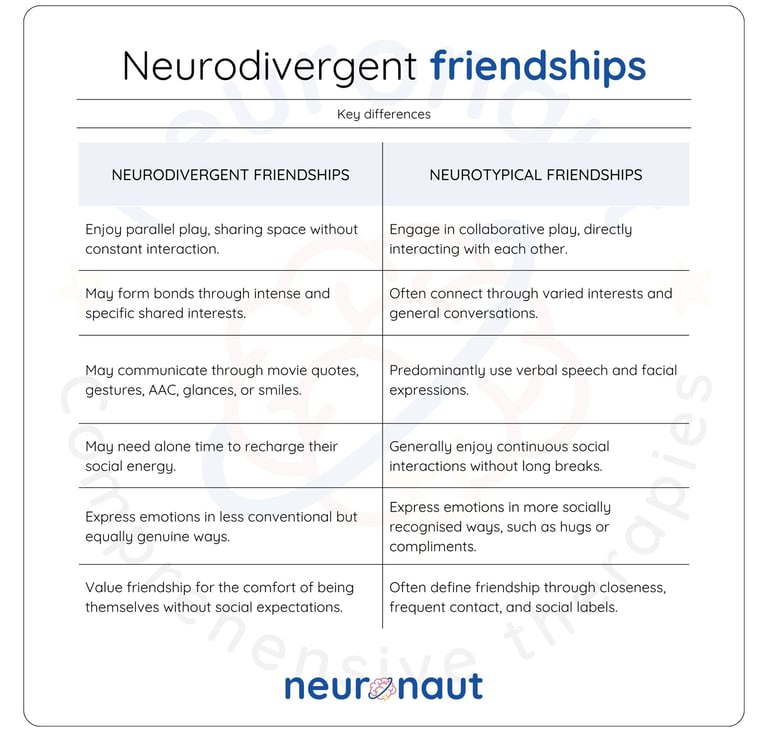Neurodivergent friendships
Explore unique, meaningful, and equally valuable neurodivergent friendships.
Andrea Olmos
2/18/20252 min read
Have you ever heard the phrase, “autistic children aren’t interested in making friends”? This misconception often extends to all neurodivergent individuals, leading many therapy goals to focus on making them more “social”. However, this approach overlooks their differences. Neurodivergent individuals do want friendships—they just socialise differently. These friendships may have unique characteristics and challenges, but they are equally valuable and enriching.
In this article, we’ll cover:
Differences in neurodivergent friendships
Examples
Comparison table
How to support
Differences in neurodivergent friendships
Neurodivergent individuals may experience and express friendship in ways that differ from neurotypical norms, such as:
Parallel play
Children might play side by side, each absorbed in their own activity, without direct interaction but enjoying each other’s presence.
Sharing special interests
Imagine finding someone who shares your intense love for dinosaurs—or someone who listens to you talk about them all day while you listen to their favourite topics.
Unique communication styles
Friendship isn’t limited to spoken words. Neurodivergent friendships may involve communicating through favourite movie quotes, gestures, augmentative and alternative communication tools, glances, or smiles.
Taking breaks
Some people need time alone to recharge their “social battery”.
These differences don’t indicate an inability to form deep, meaningful friendships. Instead, they highlight the need for mutual understanding and adaptation.
How to support neurodivergent friendships
Educate yourself
Not just about neurodivergence—autism, ADHD, dyslexia—but about the individual themselves. Learn what they like, dislike, and need.
Communicate openly
Honest conversations about preferences, needs, and boundaries prevent misunderstandings and build trust.
Plan ahead
Anticipation can make social interactions more comfortable and genuine.
Value diversity
Appreciating different ways of communicating and expressing emotions enriches friendships and promotes a more inclusive society.
In essence, while neurodivergent friendships may differ from neurotypical ones, they are just as significant and essential.
Even without hugs or labels like “best friends,” their value lies in the comfort of being one’s authentic self.


Join the conversation
If this article has inspired you or raised questions, we’d love to hear from you. Share it with others who might also benefit from these ideas and help us spread the message further.
Together, we can celebrate differences and build a society that embraces neurodiversity in all its forms.
References
Sasson, N. J., Faso, D. J., Nugent, J., Lovell, S., Kennedy, D. P., & Grossman, R. B. (2017). Neurotypical Peers are Less Willing to Interact with Those with Autism based on Thin Slice Judgments. Scientific reports, 7, 40700. https://doi.org/10.1038/srep40700
Gentle E, O’Brien P. Forming relationships through group art-making: An exploration with neurodivergent people living in regional Australia. Health Promot J Austral. 2021; 32(S2): 308–319. https://doi.org/10.1002/hpja.431
Webber, C., Santi, E., Crompton, C. J., Fletcher-Watson, S., y McGeown, S. (2024). Representación en libros de ficción: Percepciones de los jóvenes neurodivergentes de los beneficios y daños potenciales. Neurodiversidad, 2. https://doi.org/10.1177/27546330241237881
This content has been created for informational purposes only and should not replace professional evaluation. The article has been reviewed by our editorial team.
Do you have a comment?

Find us here
258 Warrigal Road, Glen Iris, VIC 3146
Follow us


ABN 93673889506
Member of UniHub Monash University

Call us

We acknowledge the Traditional Aboriginal Owners of Country and pay our respects to them, their connections to land, sea, and community. We pay our respects to their Elders past and present and future Traditional Owners.
We respect and welcome people of all backgrounds, genders, sexualities, abilities and cultures.


